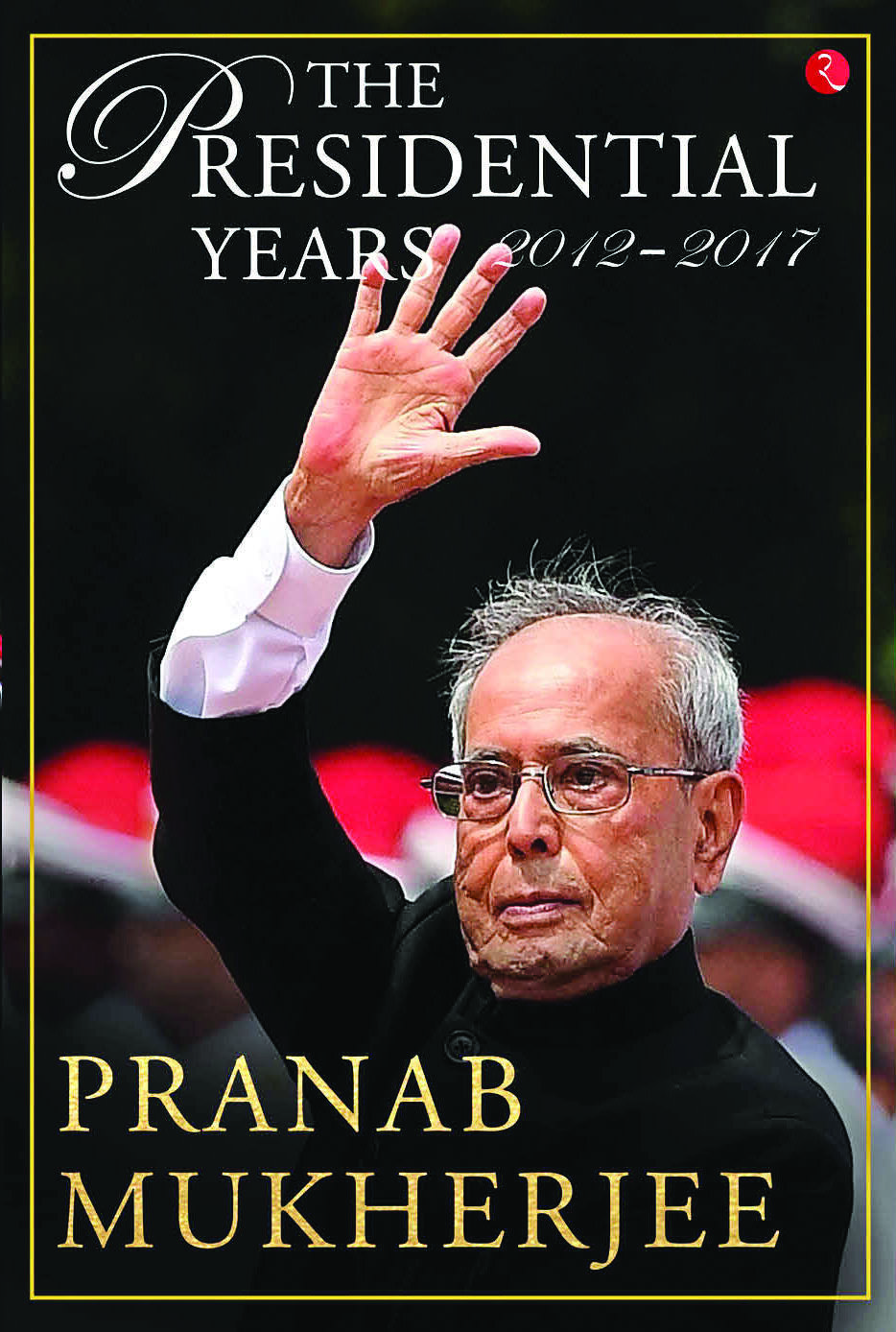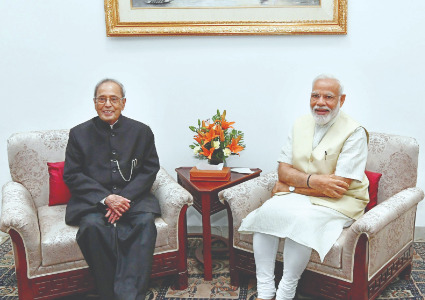"The Presidential Years: 2012-2017" | Path-breaking decisions
A fascinating account of how one of the country’s most respected veteran politicians reshaped the functioning of Rashtrapati Bhavan and responded to tumultuous events as the country’s first citizen, leaving behind a legacy that will be hard to match; Excerpts:
Author: Pranab Mukherjee
Publisher: Rupa Publications
The internal process of decision-making varies from government to government, and PM Modi has brought in a pattern where a major decision is endorsed by the cabinet or other appropriate bodies after the PMO or he himself has announced the decision. However, as per protocol, if it is a matter of policy, it is to be discussed in the cabinet, and naturally the finance minister takes the lead in initiating the discussions as desired by the PM. But in the last six years of this government, we have seen the introduction of new work procedures where most of the decisions are taken by the PMO in consultation with the departmental heads or secretaries concerned, as the case may be.

Of course, there are certain decisions that have to not only be taken at the PM’s level but also kept under wraps until their implementation. In other words, barring a select group of people led by the PM himself, nobody else is privy to the decision until its implementation at the shortest possible notice is announced. This is normally the case where an element of surprise is necessary to derive the best results. The Modi government’s decision to demonetize, within a few hours of the announcement being made, high-value currencies, with a view to deal a body blow to the domestic black money economy, was one such instance. It has been both commended and criticized, although the jury is still out on whether it has achieved its main purpose.
PM Modi had not discussed the issue of demonetization with me prior to his announcement on 8 November 2016. I learnt of it along with the rest of the country when he made it known through a televised address to the nation. There has been criticism that he should have taken lawmakers and the Opposition into confidence, before making the announcement. I am of the firm opinion that demonetization could not have been done with prior consultation because the suddenness and surprise, absolutely necessary for such announcements, would have been lost after such a process.
Therefore, I was not surprised when he did not discuss the issue with me prior to making the public announcement. It also fitted in with his style of making dramatic announcements. According to reports, he spoke of it at a cabinet meeting and got the cabinet’s consent just a short while before he went on air to tell the nation that high-value currency notes had been demonetized.
However, after delivering his address to the nation, the PM visited me at Rashtrapati Bhavan and explained to me the rationale behind his decision. Modi outlined three main objectives of demonetization: tackling black money, fighting corruption and containing terror funding. He desired an explicit support from me as a former finance minister of the country. I pointed out to him that while it was a bold step, it may lead to temporary slowdown of the economy. We would have to be extra careful to alleviate the suffering of the poor in the medium to long term. Since the announcement was made in a sudden and dramatic manner, I asked the PM if he had ensured that adequate currency was there for exchange.
Following the meeting, I issued a statement extending support to the principle of demonetization. I maintained that it was a bold step taken by the government that would help unearth unaccounted money as well as counterfeit currency. Incidentally, Bihar CM Nitish Kumar agreed to extend full support to the demonetization decision after I had endorsed it.
But demonetization wasn’t an exercise initiated only by PM Modi. It had been discussed in Parliament and raised mainly by non-Congress parties several times, particularly from the 70s to the 90s. I remember in the early 70s, I had sent a note on demonetization to the PMO after the successful implementation of the Voluntary Disclosure of Income and Wealth Ordinance, 1975. A large amount of concealed income and wealth was declared by defaulters who stood in queues for long hours before officers of the Income Tax Department, in the last three days before the scheme was scheduled to close. It was regarded as the most successful one among several such schemes announced earlier by ministers like Mahavir Tyagi, T.T. Krishnamachari and Morarji Desai in the late 50s and 60s.
Indira Gandhi, however, did not accept my suggestion, pointing out that a large part of the economy was not yet fully monetized and that a substantial part of it was in the informal sector. Under these circumstances, she argued, it would be imprudent to shake the faith of people in currency notes. After all, currency notes issued by the Reserve Bank of India (RBI) represent the commitment of a sovereign government. Except for the one-rupee note, which was signed by the finance secretary, all other currency notes above that value were, and are, signed by the RBI governor.
A similar sentiment seemed to have been echoed when, even after joining the European Economic Community—also known as the Common Market—the British government had not disturbed the faith of the citizens of its country, as well as international customers, in the currency notes issued by the sovereign government. In other words, lack of confidence in currency notes leads to lack of confidence in the credibility of the sovereign government.
Clearly, the problems associated with the demonetization policy were all well-known and the sufferings in the informal sector were also understandable. It was, therefore, natural for the decision to be questioned. Such decisions also shake the confidence of the people in the banking system. Former PM Manmohan Singh observed that as a result of demonetization, the impact on GDP growth would be at least 2 per cent negative growth—this has been established by the GDP growth numbers during the subsequent weeks of the government’s dramatic decision. He used very strong words, describing it as ‘organized loot and legalised plunder’, with regard to the limitations of withdrawal of cash from the bank. The strong expression he used was because of the fact that genuine customers of the bank deposit money in good faith so that, in case of need, they would be able to withdraw the money. That facility had been denied in the immediate aftermath of the exercise.
Demonetization had been discussed in Parliament off and on for 17 years. And yet, when the announcement came, it brought with it a good amount of shock. Let us not forget that everyone is impacted by unaccounted cash in daily life, and unaccounted cash is amassed through the non-payment of taxes. Adequate measures were not taken to obviate the attendant problems that people faced. Further, large parts of the country continue to remain unmonetized and the practice of barter system continues in tribal areas. There is no doubt that demonetization and the consequential decisions of the government have had an adverse impact on the economy and GDP growth, resulting in an increase in unemployment in the medium term. The informal sector of the economy, which dealt with cash, was hurt severely.
However, it is difficult to assess the exact impact of demonetization, close to four years after it was implemented. But perhaps one thing can be stated without fear of contradiction: that the multiple objectives of the decision of demonetization, as stated by the government, to bring back black money, paralyse the operation of the black economy and facilitate a cashless society, etc., have not been met.
GOODS AND SERVICES TAX
The GST law is, in a way, the most effective economic legislation since the Constitution of India was enacted and operationalized. Its introduction was a momentous event for the nation.
The genesis of this path-breaking tax reform can be traced back to the year 2000 when PM Atal Bihari Vajpayee formed a committee to review the GST plan under the chairmanship of Asim Dasgupta, the then finance minister of West Bengal. The Kelkar Task Force on the implementation of the Fiscal Responsibility and Budget Management Act, 2003, had also suggested a comprehensive GST based on the value-added tax (VAT) principle.
Thereafter, the first concrete idea of GST came in the 2006 budget speech of P. Chidambaram in UPA-1. He referred the proposal to an Empowered Committee (EC) of State Finance Ministers chaired by Dasgupta, with a view to design a road map for the implementation of GST. In April 2008, the committee submitted its report to the central government, titled ‘A Model and Road map for Goods and Services Tax (GST) in India’, containing broad recommendations about the structure and design of GST. Hectic activity began thereafter to convert this idea into reality, though there was a period earlier when there was a complete standstill in the progress of GST.
Action was initiated in March 2009 (incidentally, I took over as the finance minister as an additional responsibility to my charge of external affairs), when the Department of Revenue made some suggestions to the design and structure of the GST. During my tenure as finance minister, I undertook the task to take forward the GST idea with strong determination. An attempt was made to develop a consensus for the passage of the bill by reactivating the functioning of a panel of state finance ministers, to be known as the GST Council, presided over by the union finance minister. To facilitate the constitutional requirement to have the competence to make the legislation, a Constitutional Amendment was passed with a majority and with the requisite number of state legislatures on board. A discussion paper was also drafted and circulated, and the discussions proceeded as per that discussion paper.
Based on the inputs from the Government of India and the states, the EC released its first discussion paper of GST on 10 November 2009, with the objective of generating a debate among all the stakeholders. Due to the political alignment, some of the states raised the issue of fiscal autonomy in the EC, through the finance ministers of Gujarat and Madhya Pradesh. That same year, in order to take the GST-related work further, a Joint Working Group consisting of representatives from the Union and the states was constituted. This was further trifurcated into three sub-working groups to concentrate separately on draft legislations that were needed for the GST, process and forms to be followed in the GST regime and the information technology (IT) infrastructure needed. The framework for the IT platform for GST implementation was laid under the chairmanship of Nandan Nilekani and a special purpose vehicle with cabinet approval was also set up.
There is no doubt that there had been a lack of political consensus on the constitutional amendments to provide the necessary legislative framework for GST. Some of the members of the EC were afraid of making changes to the existing structure. As a result, as finance minister, I had around 20 meetings with the CMs, and chairman and all members of the panel. Between 11 June 2009 and 17 April 2012, as many as 16 meetings were conducted by me with state finance ministers, members of the empowered panel, full panel (with me as chairman) and CMs. I visited Ahmedabad to meet the Gujarat CM; Patna, to meet the Bihar CM; Hyderabad, to discuss with the Andhra Pradesh CM; and also Mumbai, to deliberate with the Maharashtra CM. In fact, in 29 months, I held no less than 20 meetings.
Excerpted with permission
from The Presidential Years;
published by Rupa Publications



